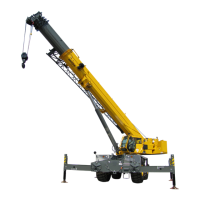SAFETY PRECAUTIONS 1300A OPERATOR’S MANUAL
2-6
Published 12-21-2011 CTRL #050-09
upon the direction from which the wind is blowing (e.g., wind
on the rear of the boom can result in decreased forward
stability, wind on the underside of the boom can result in
decreased backward stability, wind on the side of the boom
can result in structural damages, etc.). To assist you in
determining prevailing wind conditions, refer to Table 2-1.
Wind forces can exert extreme dynamic loads. Manitowoc
recommends that a lift not be made if the wind can cause
a loss of control in handling the load. Manitowoc
recommends that, if the wind speed (velocity) is between 20
mph (32 km/h) to 30 mph (48 km/h), the load capacities shall
be reduced to account for the size and shape of the load and
the wind direction in relation to the machine for all boom and
boom extension lengths. Further, operation of the crane in
wind velocities over 30 mph (48 km/h) is not recommended.
Table 2-1
Lifting Operations
Before lifting, position the crane on a firm surface, properly
extend and set the outriggers, and level the crane.
Depending on the nature of the supporting surface,
adequate cribbing may be required to obtain a larger bearing
surface.
The crane is equipped with a bubble level that should be
used to determine whether the crane is level. The load line
can also be used to estimate the levelness of the crane by
checking to be sure it is in-line with the center of the boom at
all points on the swing circle.
If the boom extension, or auxiliary boom nose is to be used,
ensure the electrical cable and the weight for the Anti-Two-
Block Switch are properly installed and the LMI is
programmed for the crane configuration. Refer to the LMI
handbook supplied with the crane.
Verify the crane’s capacity by checking the Load Chart
against the weight of the load. Then, lift the load slightly at
first to ensure stability before proceeding with the lift.
Be sure the load is properly rigged and attached. Always
determine the weight of the load before you attempt to lift it
and remember that all rigging (slings, etc.) and lifting devices
(hook block, boom extension, etc.) must be considered part
of the load.
Measure the load radius before making a lift and stay within
approved lifting areas based on the range diagrams and
working area diagrams on the crane’s Load Chart.
Always keep the load as near to the crane and as close to
the ground as possible.
Do not overload the crane by exceeding the capacities
shown on the appropriate Load Chart. Death or serious
injury could result from the crane tipping over or failing
structurally from overload.
The crane can tip over or fail structurally if:
• The load and crane’s configuration is not within the
capacity as shown on the applicable Load Chart and
notes.
• The ground is soft and/or the surface conditions are
poor.
• Outriggers are not properly extended and set. On
models equipped with outriggers that can be pinned at
Wind Force
Wind Velocity
mph (km/h)
Visible Indicator
Effects of wind as observed on land
Beauford
Scale
Designation
Zero (0) Calm less than 1 (<2) No wind; smoke rises vertically
1 Light Air 1-3 (2-5) Wind direction seen by smoke but not by wind vanes
2 Light Breeze 4-7 (6-11) Wind felt on face; leaves rustle; wind vane moves slightly
3 Gentle Breeze 8-12 (13-19) Leaves/small twigs in constant motion: wind extends flag
4
Moderate
Breeze
13-18 (21-29) Raises dust & loose paper; moves small branches
Reduce crane load ratings and operating parameters at 20 mph (32 km/h)
5 Fresh Breeze 19-24 (31-39)
Small trees in leaf begin to sway; on ponds, crested wavelets
form
6 Strong Breeze 25-31 (40-50)
Large branches in motion; telegraph wires whistle; umbrellas
used with difficulty
Cease all craning operations at 30 mph (48 km/h); lower & retract boom
7 Moderate Gale 32-38 (52-61) Whole trees in motion; walking against wind is inconvenient
Reference Only

